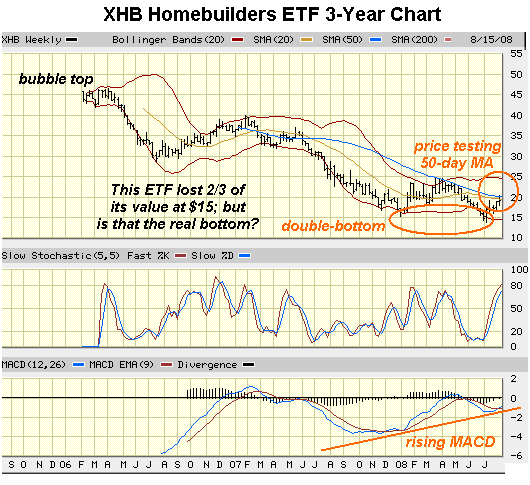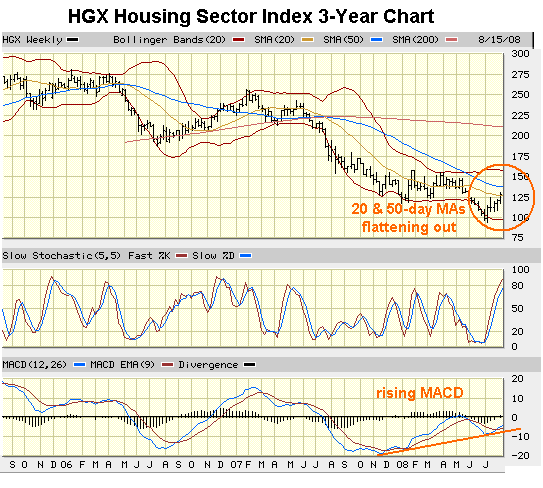(August 18, 2008)
Frequent contributor Harun I. provided a cogent summary of the fundamental
forces weighing against those anticipating a near-term bottom in housing prices.
More Home Loans on Edge
Interest-only and Alt-A borrowers may be in the next wave of foreclosures.
(Merced CA Sun-Star)
"Prices likely won't increase if supply vastly surpasses demand, but they will
only fall so far before hitting a natural bottom, he said. California's growth
rate, rental rates, construction costs and income levels help determine that level,
and O'Toole said he thinks some communities, such as Stockton, which leads the
nation in foreclosures, might already be near the bottom."
This is like saying that your injury will stop hurting when the pain goes away.
The mantra many others and I have been repeating is that home prices will fall until
they are in line with income. But I realized that is, perhaps, a gross miscalculation
which I must address. I have new hypothesis: Prices will fall below the level of
median income support; they will overshoot to the downside and bottom at "market
clearing" prices. (emphasis added: CHS) The reasons are high inventory, high unemployment, scarcity of
credit, scarcity of qualified buyers and poor sentiment.
Alt-A and Interest Only mortgages are going to be the next big wave of RRE defaults,
which will dump more inventory on the market. The number of homes on the market in
the US will take several years to clear in a normal environment but bubbles are
obviously not normal. High inventories will demand lower prices.
In other words,
if builders flooded a normal market with inventory, prices would have to lower in
order to sell those homes regardless of incomes. This factor alone is the most
important. Regardless of wages, prices will overshoot downward because there is
too much supply. One may argue that population growth will create a greater demand
and I would reply that that population must have employment and wages and be
creditworthy in order to qualify. Which brings us to the employment factor.
Don't look to BLS numbers for any realistic view of employment. By the time the
numbers are high enough that even the BLS numbers look bad, that means the problem is
already very deep. Unemployment is at a historical low, and we like to think we
can exist as a service economy but as this illusion unravels, as it is presently,
unemployment will increase. The trend will be like any other, it will persist longer
than and further than anyone thinks. High unemployment will create a shortage of
qualified buyers. This will be another factor pressuring prices. I do concede
that this implies an income factor, that factor being zero.
It is no secret that banks are in need of cash and RRE losses are nowhere near over
let alone the coming CRE debacle. Currently they have been raising money just for
losses, their ability to lend is greatly reduced. Securitized products may not be
dead forever but they are dead for now. Banks that have to keep loans on their books
are going to be discerning along more traditional lines than they were during
the bubble. It will be difficult to get a loan under normal lending standards.
This will play a role in decreasing the pool qualified buyers, which in turn,
will keep inventories high, which will pressure prices lower.
Market forces will propel long-term lending rates (risk premiums) higher regardless
of the Fed. Home prices must fall to offset the difference, as this once again will
impact the number of qualified buyers at any particular price point. The low saving
rate in the US says that most don't have a 10-20% down payment. Saving up an adequate
down payment will be harder with high unemployment and low wages. The current wave
of foreclosures will create a pool of ineligible buyers for at least 4-7 years after
the event. Even if they are considered, interests rates will be such that
prices must be lower in order for them to qualify.
Finally, poor sentiment will take hold. At some point, people will not want to have
anything to do with real estate. The losses will have been so great and gone on
for so long that the widespread idea of RE as easy road to riches will fade. This
is good, as it will mark the beginning of the bottom. When magazine covers highlight
the permanent death of the housing market it will be one of many signs that the
sector trend is about to reverse. But don't expect this anytime soon. Japan was
in much better shape to weather their bubble and though the bubble has deflated,
in reality, they still haven't recovered.
In summary, prices will fall to market clearing levels and that level is not singularly
tied to incomes. Even in normal markets prices oscillate around the mean. After
such a great distortion (bubble) it is somewhat unrealistic to think that prices
will fall right back to the mean. The deflation of home prices is nothing more than
a trend, and it will persist. Affordability is a factor in the clearing of inventory
but it is not the only factor. It is the other factors that I have mentioned here
which form a positive feedback loop which increases inventory, a combination
of factors that I believe will
cause RE prices to slip below median income support.
Thank you, Harun. Housing Bulls believe certain "backstops"
are already in place which will arrest housing's free-fall. One is low interest
rates, which as Harun observes, will be rising regardless of the Fed's
attempt to change the tides with its Fed Funds Rate sand-castle.
The second one is income, which as Harun notes, will be pressured by rising
unemployment and stagnant wage growth.
The third "backstop" is no-down/low-down payments, enabling a large pool of
households with no real savings to qualify for a mortgage. But with credit drying
up and standards rapidly being raised to limit risk, a paucity of savings will
greatly reduce the number of households who truly qualify for a conforming loan.
Recall that many households are so burdened with debt (auto loans, student loans,
credit cards, etc.) the notion that they are low-risk candidates for immense new
mortgages does not align with the new "recognition of risk" lending realities.
A fourth backstop is "replacement value," a notion which I have seen
used recently to justify the purchase of still-overpriced properties. For instance,
"you couldn't build this for the asking price." Perhaps, but in a nation with
some 15 million vacant homes, who will be risking capital building more luxury homes
in markets glutted with vacant luxury homes and condos?
Bottom line: replacement value shows up in appraisals, but not in the market price,
which is set by the demand of willing buyers, the ready availability of mortgages/
money to borrow and the inventory of available houses.
Supply and demand do not respect replacement values. Homes in highly
desirable urban areas with walkable neighborhoods and nearby public transit and
retail are still commanding bubble-era prices here in the San Francisco Bay Area,
as these qualities are still attracting buyers who are
qualified by virtue of huge cash down payments--vast cash positions which
in many cases were created by selling their previous homes at the bubble top 2005-2006.
These few homes are still fetching prices far above replacement, while their exurban
counterparts are slumping toward "market clearing" prices--the price at which cash
buyers appear.
Meanwhile, the stock market is "discounting" further declines in housing and
forecasting a "bottom." Take a look at these charts of the Housing Sector Index
(HGX) and the S&P Homebuilders ETF (XHB).

Both charts are showing signs of "bottoming", suggesting the market has "discounted"
current declines and is anticipating a recovery in early 2009.

Housing Bulls can certainly point to this technical evidence in making their
case that homebuilders have bottomed. But with all the traditional "backstops"
of valuations crumbling, we have to ask: as the recession finally tightens its
grip in 2009, who will be left who A) wants to take on a huge mortgage as their
income/employment gets iffier B) is
qualified for a huge mortgage by conventional lending standards and C) doesn't
already own a house (or three)?
I have been writing for two years about "false bottoms" created by
speculators overly-anxious to "bottom feed" and a media primed by its advertisers
and handlers to seek a "bottom" at the earliest possible point. This certainly
looks like just such a "false bottom." The real bottom in these indices will be closer
to zero.
New Book Notes: My new "little book of big ideas,"
Weblogs & New Media: Marketing in Crisis is now available on amazon.com. The price is currently listed at a default
of $15, but I am working on getting it lowered to $10.99. Check back
later in the week to order a copy at the lower price.
is now available on amazon.com. The price is currently listed at a default
of $15, but I am working on getting it lowered to $10.99. Check back
later in the week to order a copy at the lower price.
In other book news, the last "printer's error/collector's copy" of I-State Lines
will be shipped to contributor Claude M. These are already showing up on third
party sellers as "collectors editions" even though "me only pawn in
big game of life and literary standing."
I will endeavor to make every signed copy of any of my books a unique item or gift.
Who knows what collectors will pay in the future? Start your first-edition collection
now...
NOTE: contributions are acknowledged in the order received. Your name and email
remain confidential and will not be given to any other individual, company or agency.
Thank you, Amy C. ($20), for your very kind encouragement and generous contribution to this
site.
I am greatly honored by your support and readership.
For more on this subject and a wide array of other topics, please visit
my weblog.
All content, HTML coding, format design, design elements and images copyright ©
2008 Charles Hugh Smith, All rights
reserved in all media, unless otherwise credited or noted.
I would be honored if you linked this wEssay to your site, or printed a copy for your own use.

